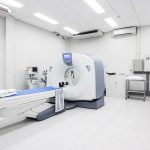
Neoadjuvant chemotherapy for breast cancer
In some patients, breast cancer treatment begins with the use of drugs (cytostatics and biological therapies) instead of the usual practice of first performing surgery to remove the tumor and lymph nodes in the armpit and then administering the drugs.
Administration of drugs before surgery is called Neoadjuvant Chemotherapy (NACT), while administration of drugs after surgery is called Adjuvant Chemotherapy (ACT).
The neoadjuvant approach is often not clear to patients and causes fear. They have the impression that their disease is particularly severe and advanced and that it is therefore not possible to perform surgery immediately after the diagnosis is made. They do not understand how not removing the tumor but leaving it in the body can be a good thing since the basic oncological postulate is that chances for recovery are better if the tumor is removed from the body as early as possible.
Administration of drugs before surgery is called Neoadjuvant Chemotherapy.
Preoperative chemotherapy can reduce larger tumors (larger than 3 cm in diameter) and significantly enlarged lymph nodes in the armpit affected by the tumor (larger than 2 cm) – which creates the conditions for breast cancer surgery to be performed with a less extensive surgical intervention and better functional and aesthetic results.
Breast cancers differ in their biological characteristics. As a result, a certain percentage of patients will not respond well to chemotherapy: their tumors will not shrink under the influence of chemotherapy. Such patients suffer double damage: 1) they receive toxic drugs that damage the body and immunity without any effect on tumor shrinkage; 2) the tumor remains in their body all that time (about 4-6 months on average) – and it could have been surgically removed much earlier – it grows and metastases, even more actively than it would have without the therapy, due to weakened immune system.
That is why it is necessary to determine the biological characteristics of the tumor as precisely as possible before starting the treatment – with immunohistochemical and genetic laboratory analyses. Based on these tests, we can determine with greater confidence whether the tumor will respond well to chemotherapy.
The only totally reliable therapeutic effect in oncology is the surgical removal of tumor tissue from the body, as soon as possible after the tumor is discovered.
The only totally reliable therapeutic effect in oncology is the surgical removal of tumor tissue from the body, as soon as possible after the tumor is discovered.
Scientifically proven facts about neoadjuvant chemotherapy:
- There is no difference in patient survival when it comes to whether chemotherapy is administered before or after surgery, or partly before and partly after surgery.
- The only proven beneficial therapeutic effect of chemotherapy administered before surgery is related to surgery: shrinking large breast tumors makes cancer surgery more straightforward and less extensive.
- After neoadjuvant chemotherapy, local recurrence (reappearance of tumor in the operated area) is significantly more frequent compared to that in patients undergoing surgery first. This does not affect survival rates but requires a new surgery – usually a mastectomy.
- During neoadjuvant chemotherapy, we get useful information about the tumor sensitivity to chemotherapy as the tumor has not been removed, so we can monitor whether it shrinks with the therapy or not. We also get helpful information about the disease prognosis, as tumors that disappear entirely with chemotherapy have a better prognosis. However, this information alone does not have a therapeutic effect, that is, it does not improve survival rates. Survival rates would have been the same if chemotherapy had been administered after removing the tumor from the breast. The only thing is that in that case we would not know that it was a tumor that would have disappeared entirely with chemotherapy.
The complete disappearance of the tumor during neoadjuvant chemotherapy does not contribute to the quality of surgical treatment. Scientific studies show that in these cases, surgeons more often resort to mastectomy than sparing surgery since they do not have reliable and precise information about the tumor position in the breast before chemotherapy.
Based on the above scientifically proven facts, the surgical team of “M. C. Aesculap” formulated its views on the application of neoadjuvant chemotherapy in breast cancer:
- Neoadjuvant chemotherapy is recommended for patients with locally advanced cancer that is initially inoperable or at the limit of operability or large tumors that require a mastectomy, and there is a real possibility that after chemotherapy, the tumor will shrink and thus allow sparing surgery.
- The surgeon primarily assesses the need for preoperative (neoadjuvant) chemotherapy. When the surgeon, based on the size of the tumor and the lymph nodes in the axilla, as well as the calculated perspectives of surgical treatment, assesses that preoperative chemotherapy would significantly contribute to surgery quality, the surgeon suggests a “core” biopsy of the tumor. A biopsy is used to make a histological diagnosis of cancer and determine its biological characteristics.
- The patient is referred for neoadjuvant chemotherapy only if the biological characteristics show that cancer will respond well to chemotherapy. Otherwise, surgery is performed immediately.
- The definitive decision on neoadjuvant chemotherapy is always made in agreement with the patient after the surgeon has thoroughly informed the patient about all aspects of such treatment.
- Intensive monitoring is mandatory during chemotherapy, usually for two weeks after each cycle. Magnetic resonance imaging is the ideal monitoring tool, but ultrasound measurement of the tumor size and affected lymph nodes in the armpit is also satisfactory.
- Surgery is performed at the optimal moment when the tumor becomes operable, or sparing surgery is possible, but before the tumor has completely disappeared. The remainder of chemotherapy is administered after surgery.
- Given the increased risk of local recurrence, post neoadjuvant chemotherapy surgeries are performed using a special technique of stereotaxic marking of the pre-treatment position and volume of the tumor with intraoperative ultrasound. This technique is the proprietary surgical technique of the “M. C. Aesculap” surgical team.









